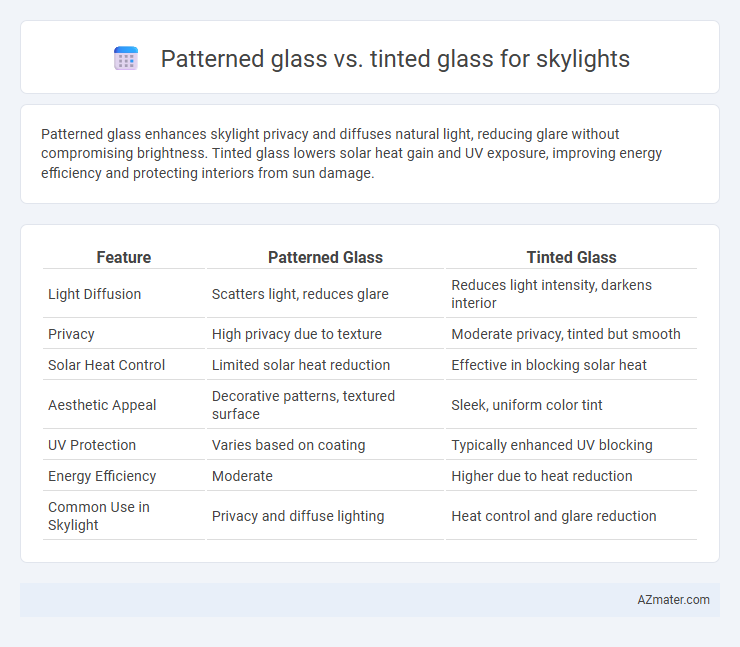Patterned glass enhances skylight privacy and diffuses natural light, reducing glare without compromising brightness. Tinted glass lowers solar heat gain and UV exposure, improving energy efficiency and protecting interiors from sun damage.
Table of Comparison
| Feature | Patterned Glass | Tinted Glass |
|---|---|---|
| Light Diffusion | Scatters light, reduces glare | Reduces light intensity, darkens interior |
| Privacy | High privacy due to texture | Moderate privacy, tinted but smooth |
| Solar Heat Control | Limited solar heat reduction | Effective in blocking solar heat |
| Aesthetic Appeal | Decorative patterns, textured surface | Sleek, uniform color tint |
| UV Protection | Varies based on coating | Typically enhanced UV blocking |
| Energy Efficiency | Moderate | Higher due to heat reduction |
| Common Use in Skylight | Privacy and diffuse lighting | Heat control and glare reduction |
Introduction to Skylight Glass Options
Skylight glass options include patterned glass and tinted glass, each offering distinct benefits for light diffusion and energy efficiency. Patterned glass enhances privacy and reduces glare by scattering sunlight, making it ideal for spaces requiring softened natural light. Tinted glass lowers solar heat gain and UV exposure, contributing to cooler interiors and protecting furnishings while preserving outward visibility.
What is Patterned Glass?
Patterned glass for skylights features textured or embossed designs that provide privacy and diffuse natural light while reducing glare. This type of glass enhances aesthetic appeal and adds a decorative element without compromising brightness in the space below. Unlike tinted glass, which darkens and limits light transmission, patterned glass maintains high light diffusion with minimal heat gain.
What is Tinted Glass?
Tinted glass for skylights is engineered with special coatings or additives that reduce solar heat gain and glare by filtering out specific wavelengths of light. This type of glass enhances energy efficiency by minimizing the amount of ultraviolet (UV) and infrared (IR) radiation entering a space, helping to maintain comfortable interior temperatures. Unlike patterned glass, which obscures visibility for privacy, tinted glass primarily focuses on controlling light transmission while maintaining clear views.
Light Transmission Comparison
Patterned glass for skylights diffuses sunlight, reducing glare while maintaining moderate light transmission, typically allowing around 40-70% of natural light to pass through depending on the pattern density. Tinted glass decreases overall light transmission by absorbing a portion of sunlight, usually transmitting between 30-50%, effectively reducing heat gain and UV rays but resulting in dimmer indoor lighting. Choosing between patterned and tinted glass depends on balancing desired daylight levels, privacy, and energy efficiency in skylight applications.
Privacy and Aesthetic Appeal
Patterned glass enhances privacy by obscuring clear views while allowing natural light to diffuse softly, making it ideal for skylights in spaces requiring discreet illumination. Tinted glass reduces glare and heat by filtering sunlight, offering a sleek, modern aesthetic that complements contemporary architectural designs. Both options improve the visual appeal and functionality of skylights, with patterned glass emphasizing privacy and tinted glass focusing on energy efficiency and style.
Heat and UV Protection
Patterned glass for skylights offers moderate heat reduction and diffuses sunlight, providing some UV protection while maintaining privacy. Tinted glass significantly reduces solar heat gain and blocks a higher percentage of harmful UV rays, enhancing energy efficiency and protecting interior furnishings. Choosing tinted glass maximizes heat and UV protection, whereas patterned glass balances light diffusion with mild heat control.
Energy Efficiency Considerations
Patterned glass for skylights diffuses natural light, reducing glare while maintaining privacy but typically offers moderate solar heat gain control. Tinted glass absorbs and reflects a portion of solar energy, significantly lowering heat transfer and improving energy efficiency by reducing cooling loads. Selecting the right glass type depends on climate, desired daylight levels, and specific energy-saving goals for the building.
Cost Differences
Patterned glass skylights generally cost more than tinted glass due to the complexity of manufacturing and decorative design processes. Tinted glass offers a more budget-friendly option by providing solar control benefits and reducing glare without the intricate patterns that increase production expenses. Choosing between patterned and tinted glass largely depends on balancing aesthetic appeal with cost efficiency for skylight installations.
Maintenance and Durability
Patterned glass for skylights offers enhanced scratch resistance and hides dirt and smudges better, reducing the frequency of cleaning while maintaining aesthetic appeal. Tinted glass, with its UV filtering properties, protects against sun damage and reduces heat buildup but may require more frequent cleaning to prevent visible dust and streaks. Both options provide durable solutions, though patterned glass typically demands less maintenance over time due to its textured surface.
Choosing the Right Glass for Your Skylight
Patterned glass offers enhanced privacy and diffuses natural light, making it ideal for skylights in bathrooms or spaces requiring subtle illumination, while tinted glass reduces glare and heat gain, improving energy efficiency in rooms exposed to direct sunlight. When choosing the right glass for your skylight, consider factors such as light diffusion, privacy needs, solar heat control, and aesthetic preferences. Selecting between patterned and tinted glass depends on balancing natural light quality with thermal comfort and visual privacy tailored to your specific space.

Infographic: Patterned glass vs Tinted glass for Skylight
 azmater.com
azmater.com